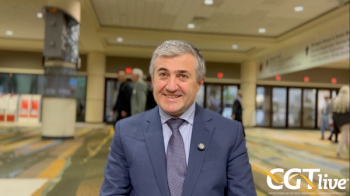
Children with SMA1 Show Remarkable Progress on Gene Therapy
Children receiving AVXS-101 have shown such improvement that researchers are calling for an update to the CHOP-INTEND scale used to track their progress.
Researchers testing AVXS-101 gene therapy for the treatment of children with spinal muscular atrophy type 1 reported remarkable progress on the Children's Hospital of Philadelphia Infant Test of Neuromuscular Disorders (CHOP-INTEND) scale, especially for children treated at less than 3 months of age.
Furthermore, the phase 1 study results prompted researchers to call for updates to the CHOP-INTEND scale. They said adding more advanced items will measure progress in children who are reaching previously unanticipated motor function milestones.
The untreated progression of spinal muscular atrophy type 1 (SMA1) is such that by 6 months, almost no patients with SMA1 score >40 points on CHOP-INTEND (maximum score 64).
“Infants with SMA type 1 never sit up unassisted,” said Linda Lowes, PhD, a researcher at the Center for Gene Therapy, Nationwide Children’s Hospital, Columbus, Ohio, who presented the study results at the American Academy of Neurology Annual Meeting. “They continue to decline rapidly, and they can never get a [CHOP-INTEND] score over 40.”
Although all the patients showed noteworthy progress, the children treated at younger ages improved more quickly said Lowes. This included patients who had the lowest baseline scores.
Lowes drew attention to 3 patients who entered the trial with CHOP-INTEND scores below 20. “All 3 of these children came to us on pain killers and palliative care,” said Lowes. “The children who were dosed early sat quite a bit better and more quickly because they were [treated] early.”
One child in particular made impressive progress that continued after the trial completion. “He was a sick little pumpkin and he was dosed early and is now standing with support.”
Children treated at ≤3 months were able to sit unassisted at a younger age (median 11.9 months of age) than those dosed at >3 months (median 22.2 months of age).
Even the 3 children with very low baseline CHOP-INTEND (≤20), who were treated at ≤3 months, were able to sit unassisted for ≥5 seconds at median age of 17.6 months and for ≥30 seconds at median age of 21.1 months.
“What we would like to point out is the essential newborn screening proposals,” said Lowes. “Everyone we treated improved, but we know that treating early is more likely to give us a more rapid and improved outcome.”
In her second presentation, Lowes called attention to the need for an updated assessment tool for children with spinal muscular atrophy type 1. Patients in the AVXS-101 trial have done so well that the standard CHOP-INTEND scale no longer accommodates their progress.
“What we’re finding is that as the kids get better and they achieve milestones that have never been heard of, [their scores] plateau,” said Lowes. “There are not items designed to capture skills that we had no idea would ever exist.”
Lowes noted that CHOP-INTEND was developed for tracking motor function in untreated children with SMA1. The scale does not currently capture skills including independent rolling and sitting that children with SMA1 have not previously been capable of achieving.
“It’s a different child that we’re testing now,” she said.
The US Food and Drug Administration has granted AVXS-101 an Orphan Drug Designation for the treatment of all types of SMA, as well as Breakthrough Therapy Designation and Fast Track Designation, for the treatment of spinal muscular atrophy type 1.
The presentations, “
Newsletter
Stay at the forefront of cutting-edge science with CGT—your direct line to expert insights, breakthrough data, and real-time coverage of the latest advancements in cell and gene therapy.

















































